Effects of Thermal-Strain-Induced Atomic Intermixing on the Interfacial and Photoluminescence Properties of InGaAs/AlGaAs Multiple Quantum Wells
Abstract
:1. Introduction
2. Experimental Section
3. Results and Discussion
4. Conclusions
Author Contributions
Funding
Institutional Review Board Statement
Informed Consent Statement
Data Availability Statement
Conflicts of Interest
References
- Yu, J.S.; Song, J.D.; Lee, Y.T.; Lim, H. Effects of rapid thermal annealing on the optical properties of In0.53Ga0.47As/In0.52Al0.48As multiple quantum wells with InGaAs and dielectric capping layers. J. Appl. Phys. 2002, 91, 2080–2084. [Google Scholar] [CrossRef]
- Taniguchi, H.; Ishii, H.; Minato, R.; Ohki, Y.; Namegaya, T.; Kasukawa, A. 25-W 915-nm lasers with window structure fabricated by impurity-free vacancy disordering (IFVD). IEEE J. Sel. Top. Quantum Electron. 2007, 13, 1176–1179. [Google Scholar] [CrossRef]
- Yu, J.; Song, J.; Lee, Y.; Lim, H. Fabrication of multi-wavelength In0.2Ga0.8As/GaAs multiple quantum well laser diodes by area-selective impurity-free vacancy disordering using SiOx capping layers with different stoichiometries. Appl. Phys. A 2005, 80, 847–850. [Google Scholar] [CrossRef]
- Vostokov, N.; Revin, M.; Shashkin, I.S. Microwave detector diodes based on InGaAs/AlGaAs/GaAs heterostructures. J. Appl. Phys. 2020, 127, 044503. [Google Scholar] [CrossRef]
- Zucker, J.; Tell, B.; Jones, K.; Divino, M.; Brown-Goebeler, K.; Joyner, C.; Miller, B.; Young, M. Large blueshifting of InGaAs/InP quantum-well band gaps by ion implantation. Appl. Phys. Lett. 1992, 60, 3036–3038. [Google Scholar] [CrossRef]
- Djie, H.S.; Mei, T. Plasma-induced quantum well intermixing for monolithic photonic integration. IEEE J. Sel. Top. Quantum Electron. 2005, 11, 373–382. [Google Scholar] [CrossRef]
- Wolf, T.; Shieh, C.L.; Engelmann, R.; Alavi, K.; Mantz, J. Lateral refractive index step in GaAs/AlGaAs multiple quantum well waveguides fabricated by impurity-induced disordering. Appl. Phys. Lett. 1989, 55, 1412–1414. [Google Scholar] [CrossRef]
- Marsh, J.H.; Cusumano, P.; Bryce, A.C.; Ooi, B.S.; Ayling, S.G. GaAs/AlGaAs photonic integrated circuits fabricated using impurity-free vacancy disordering. In Functional Photonic Integrated Circuits; SPIE: Bellingham, WA, USA, 1995; pp. 74–85. [Google Scholar]
- Yu, J.S.; Song, J.D.; Lee, Y.T.; Lim, H. Influence of dielectric deposition parameters on the In0.2Ga0.8As/GaAs quantum well intermixing by impurity-free vacancy disordering. J. Appl. Phys. 2002, 92, 1386–1390. [Google Scholar] [CrossRef]
- Zhongliang, Q.; Xiaohong, T.; Kenneth, L.E.K.; Huei, L.P.; BaoXue, B. Large energy band-gap tuning of 980 nm InGaAs/InGaAsP quantum well structure via quantum well intermixing. Solid-State Electron. 2013, 79, 281–284. [Google Scholar] [CrossRef]
- Hulko, O.; Thompson, D.A.; Simmons, J.G. Comparison of quantum well interdiffusion on group III, group V, and combined groups III and V sublattices in GaAs-based structures. IEEE J. Sel. Top. Quantum Electron. 2008, 14, 1104–1112. [Google Scholar] [CrossRef]
- Ludewig, P.; Reinhard, S.; Jandieri, K.; Wegele, T.; Beyer, A.; Tapfer, L.; Volz, K.; Stolz, W. MOVPE growth studies of Ga (NAsP)/(BGa)(AsP) multi quantum well heterostructures (MQWH) for the monolithic integration of laser structures on (001) Si-substrates. J. Cryst. Growth. 2016, 438, 63–69. [Google Scholar] [CrossRef]
- Wegele, T.; Beyer, A.; Ludewig, P.; Rosenow, P.; Duschek, L.; Jandieri, K.; Tonner, R.; Stolz, W.; Volz, K. Interface morphology and composition of Ga(NAsP) quantum well structures for monolithically integrated LASERs on silicon substrates. J. Phys. D Appl. Phys. 2016, 49, 075108. [Google Scholar] [CrossRef]
- Mitsuhara, M.; Ogasawara, M.; Sugiura, H. Effect of strain in the barrier layer on structural and optical properties of highly strained In0.77Ga0.23As/InGaAs multiple quantum wells. J. Cryst. Growth. 2000, 210, 463–470. [Google Scholar] [CrossRef]
- Ryu, S.W.; Kim, I.; Choe, B.D.; Jeong, W.G. The effect of strain on the interdiffusion in InGaAs/GaAs quantum wells. Appl. Phys. Lett. 1995, 67, 1417–1419. [Google Scholar] [CrossRef]
- Gareso, P.; Tan, H.H.; Jagadish, C. Impurity Free Vacancy Disordering (IFVD) of InGaAs/AlGaAs Quantum Well Laser Structures. ECS J. Solid State Sci. 2017, 6, N122. [Google Scholar] [CrossRef]
- Al-Jabr, A.; Majid, M.A.; Alias, M.S.; Anjum, D.H.; Ng, T.K.; Ooi, B.S. Large bandgap blueshifts in the InGaP/InAlGaP laser structure using novel strain-induced quantum well intermixing. J. Appl. Phys. 2016, 119, 135703. [Google Scholar] [CrossRef]
- Wang, X.; Cui, X.; Bhat, A.; Savage, D.E.; Reno, J.L.; Lagally, M.G.; Paiella, R. Ultrawide strain-tuning of light emission from InGaAs nanomembranes. Appl. Phys. Lett. 2018, 113, 201105. [Google Scholar] [CrossRef]
- Gareso, P.; Buda, M.; Fu, L.; Tan, H.; Jagadish, C. Influence of SiO2 and TiO2 dielectric layers on the atomic intermixing of InxGa1−xAs/InP quantum well structures. Semicond. Sci. Technol. 2007, 22, 988. [Google Scholar] [CrossRef]
- Hao, X.; Li, L.; Kong, Q.; Ma, S.; Wang, J.; Xu, Y.; Liu, X.; Han, B.; Qiu, B.; Xu, B. Atomic-scale insights of the effect of growth temperature on the migration behavior of Al atoms in InGaAs/AlGaAs multiple quantum wells. Mater. Sci. Semicond. Process. 2023, 154, 107197. [Google Scholar] [CrossRef]
- Liu, Q.; Han, D.; Ma, S.; Hao, X.; Wei, Y.; Cao, B.; Zhang, S.; Hou, Y.; Shang, L.; Han, B.; et al. Effect of in situ degradation on the atomic structure and optical properties of GaN-based green light-emitting diodes. Appl. Phys. Lett. 2020, 117, 212103. [Google Scholar] [CrossRef]
- Liu, Q.; Han, D.; Shang, L.; Hao, X.; Hou, Y.; Zhang, S.; Cao, B.; Han, B.; Shan, H.; Yang, Y.; et al. Effect of V-Shaped pits on optical properties of GaN-Based green light-emitting diodes. Opt. Mater. 2020, 107, 110129. [Google Scholar] [CrossRef]
- Ma, S.; Li, L.; Kong, Q.; Xu, Y.; Liu, Q.M.; Zhang, S.; Zhang, X.; Han, B.; Qiu, B.; Xu, B.; et al. Atomic-scale insights of indium segregation and its suppression by GaAs insertion layer in InGaAs/AlGaAs multiple quantum wells. Chin. Phys. B 2022, 32, 037801. [Google Scholar] [CrossRef]
- Zhang, B.; Wang, H.; Wang, X.; Wang, Q.; Fan, J.; Zou, Y.; Ma, X. Effect of GaAs insertion layer on the properties improvement of InGaAs/AlGaAs multiple quantum wells grown by metal-organic chemical vapor deposition. J. Alloys Compd. 2021, 872, 159470. [Google Scholar] [CrossRef]
- Fu, L.; Wong-Leung, J.; Deenapanray, P.; Tan, H.; Jagadish, C.; Gong, B.; Lamb, R.; Cohen, R.; Reichert, W.; Dao, L. Suppression of interdiffusion in GaAs/AlGaAs quantum-well structure capped with dielectric films by deposition of gallium oxide. J. Appl. Phys. 2002, 92, 3579–3583. [Google Scholar] [CrossRef]
- Ooi, B.S.; McIlvaney, K.; Street, M.W.; Helmy, A.S.; Ayling, S.G.; Bryce, A.C.; Marsh, J.H.; Roberts, J. Selective quantum-well intermixing in GaAs-AlGaAs structures using impurity-free vacancy diffusion. IEEE J. Quantum Electron. 1997, 33, 1784–1793. [Google Scholar]
- Seo, J.H.; Seo, K.S. Strain relaxation of InGaAs/GaAs superlattices by wet oxidation of underlying AlAs layer. Appl. Phys. Lett. 1998, 72, 1466–1468. [Google Scholar] [CrossRef]
- Sarıkavak, B.; Öztürk, M.; Mammadov, T.; Özçelik, S. Interdiffusion phenomena in InGaAs/GaAs superlattice structures. Cryst. Res. Technol. 2010, 45, 517–524. [Google Scholar] [CrossRef]
- Liu, S.; Yang, J.; Zhao, D.; Jiang, D.; Liang, F.; Chen, P.; Zhu, J.; Liu, Z.; Liu, W.; Xing, Y. The influence of thermal annealing process after GaN cap layer growth on structural and optical properties of InGaN/InGaN multi-quantum wells. Opt. Mater. 2018, 86, 460–463. [Google Scholar] [CrossRef]
- Vurgaftman, I.; Meyer, J.Á.; Ram-Mohan, L.Á. Band parameters for III–V compound semiconductors and their alloys. J. Appl. Phys. 2001, 89, 5815–5875. [Google Scholar] [CrossRef]
- Kudo, M.; Mishima, T. Improved photoluminescence properties of highly strained InGaAs/GaAs quantum wells grown by molecular-beam epitaxy. J. Appl. Phys. 1995, 78, 1685–1688. [Google Scholar] [CrossRef]
- Minch, J.; Park, S.; Keating, T.; Chuang, S. Theory and experiment of InGaAsP and InGaAlAs long-wavelength strained quantum-well lasers. IEEE J. Quantum Electron. 1999, 35, 771–782. [Google Scholar] [CrossRef]
- Jensen, J.R.; Hvam, J.M.; Langbein, W. Optical properties of InAlGaAs quantum wells: Influence of segregation and band bowing. J. Appl. Phys. 1999, 86, 2584–2589. [Google Scholar] [CrossRef]
- Micallef, J.; Li, E.H.; Weiss, B.L. The effects of strain on the confinement profile of disordered InGaAs/GaAs single quantum wells. Superlattices Microstruct. 1993, 13, 125–132. [Google Scholar] [CrossRef]

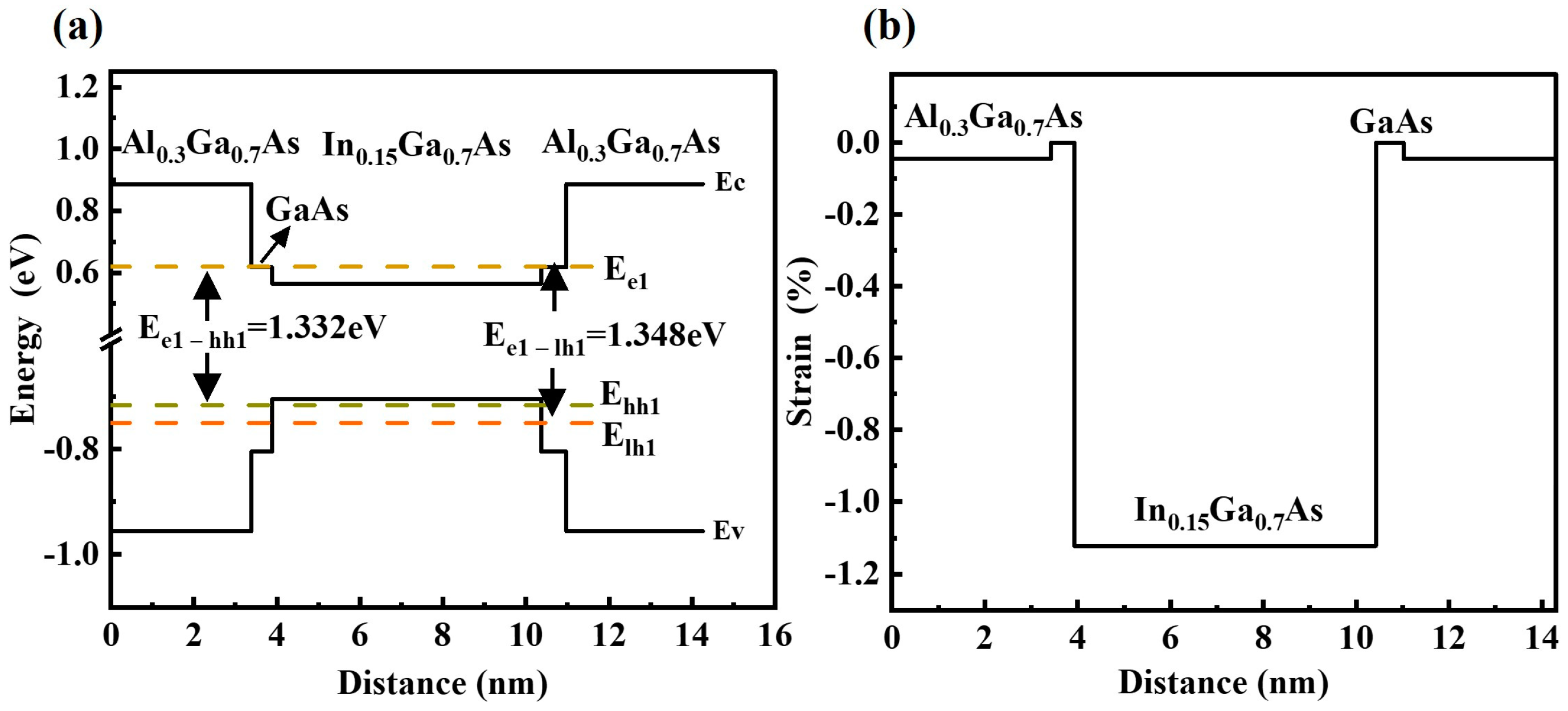
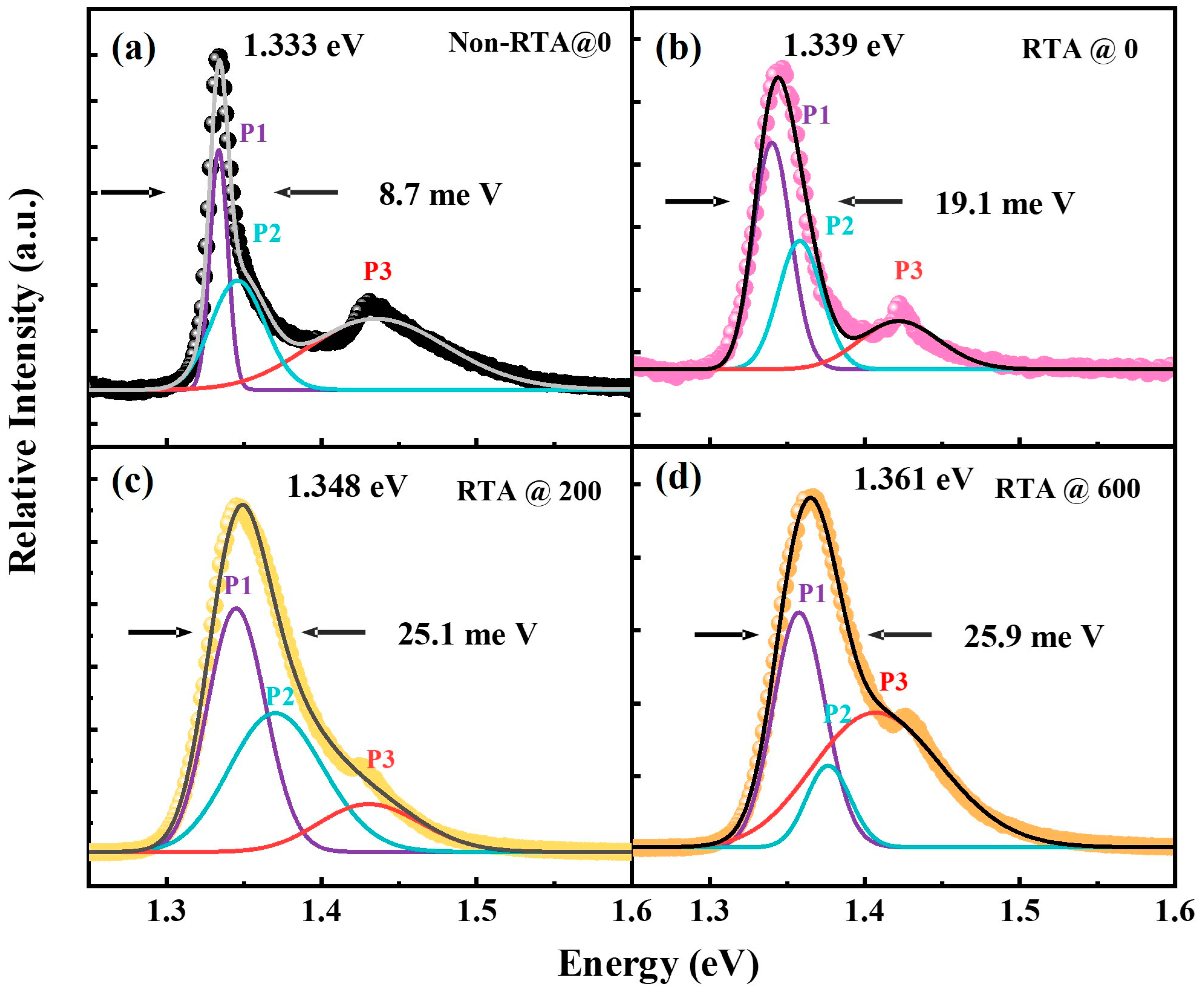
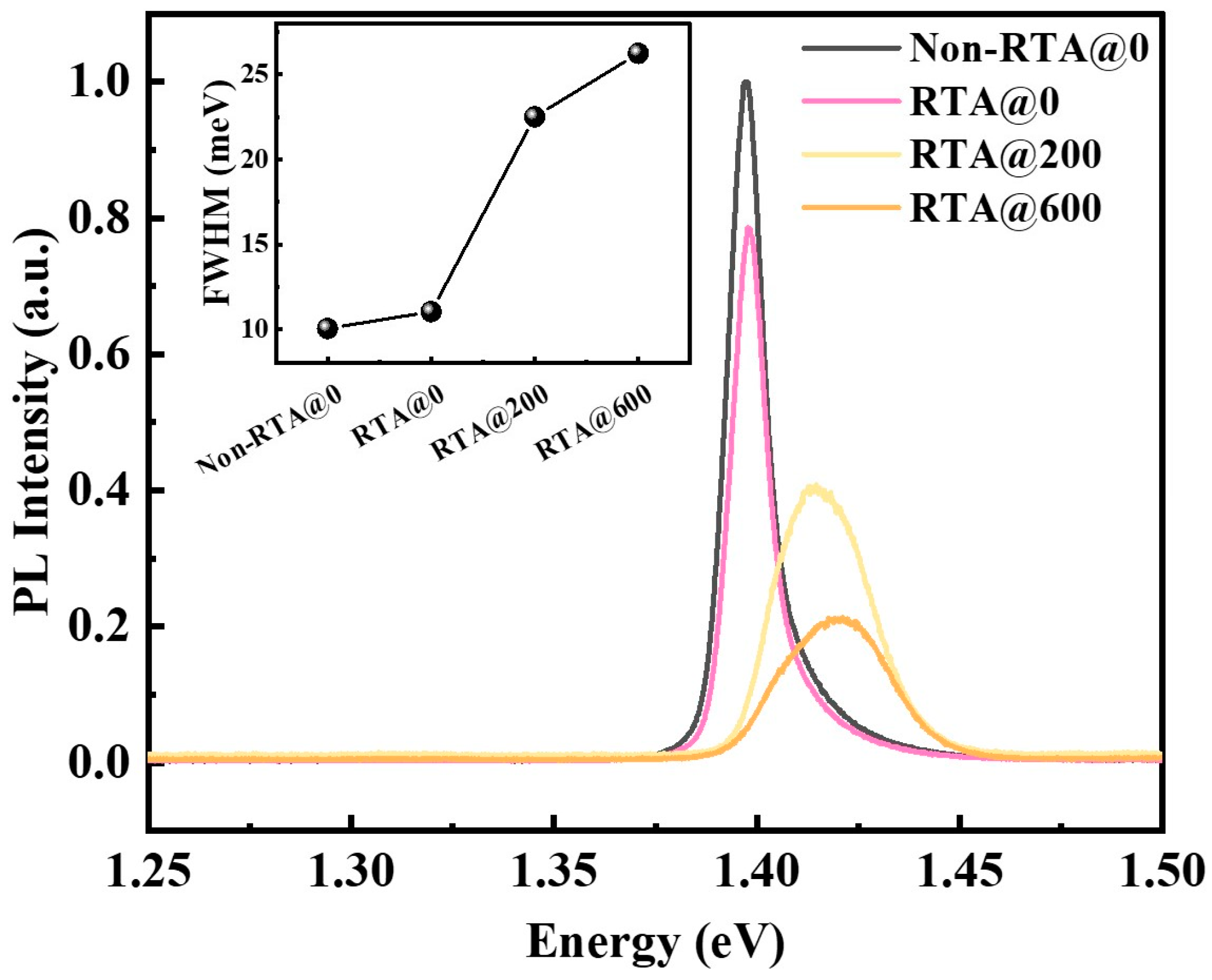
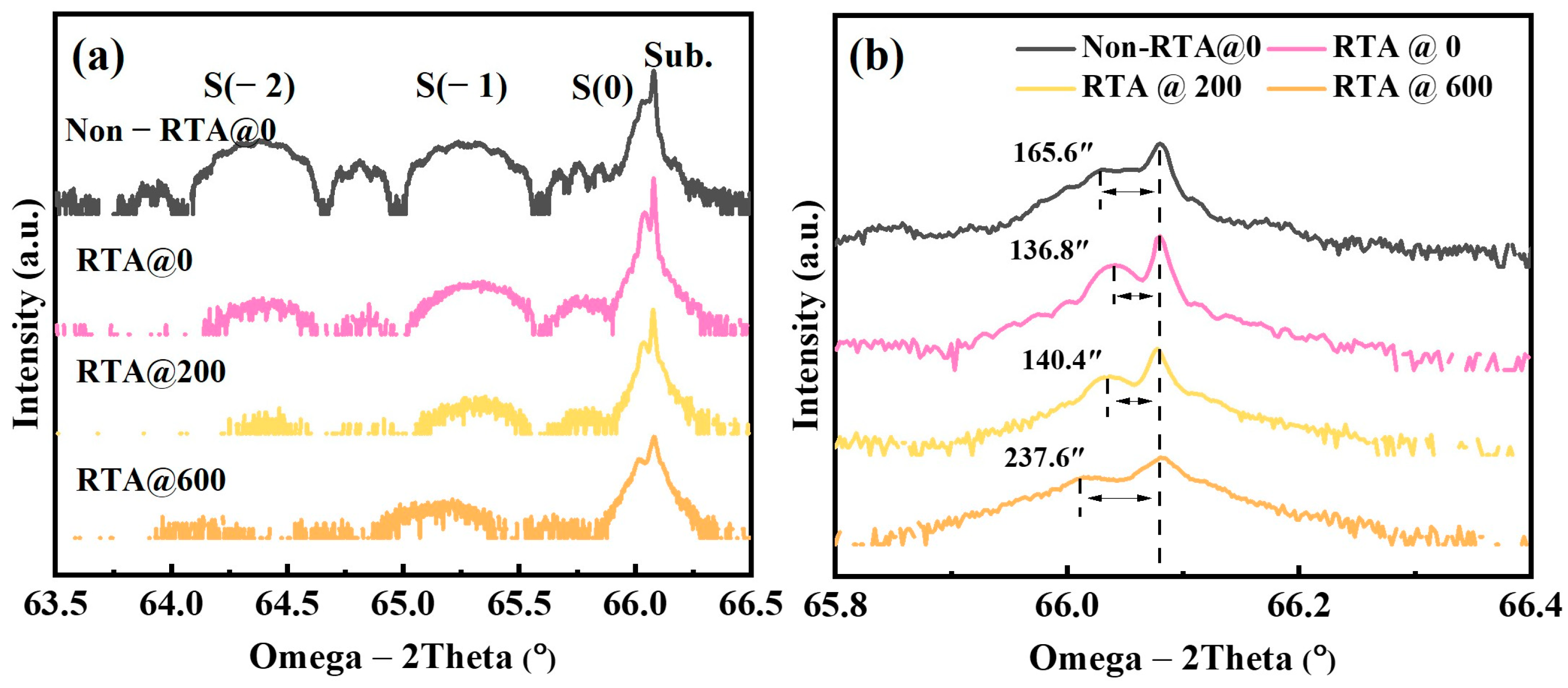
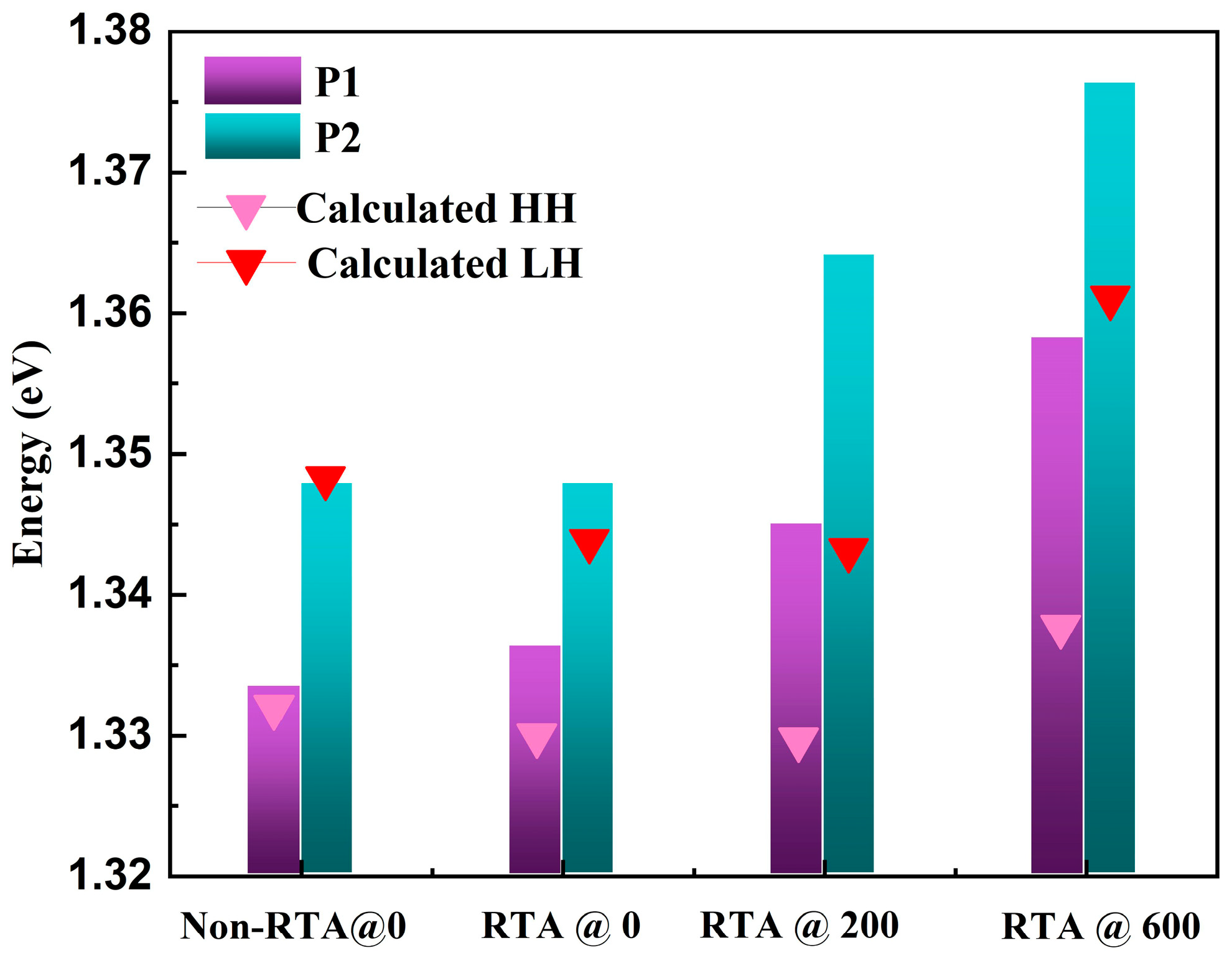
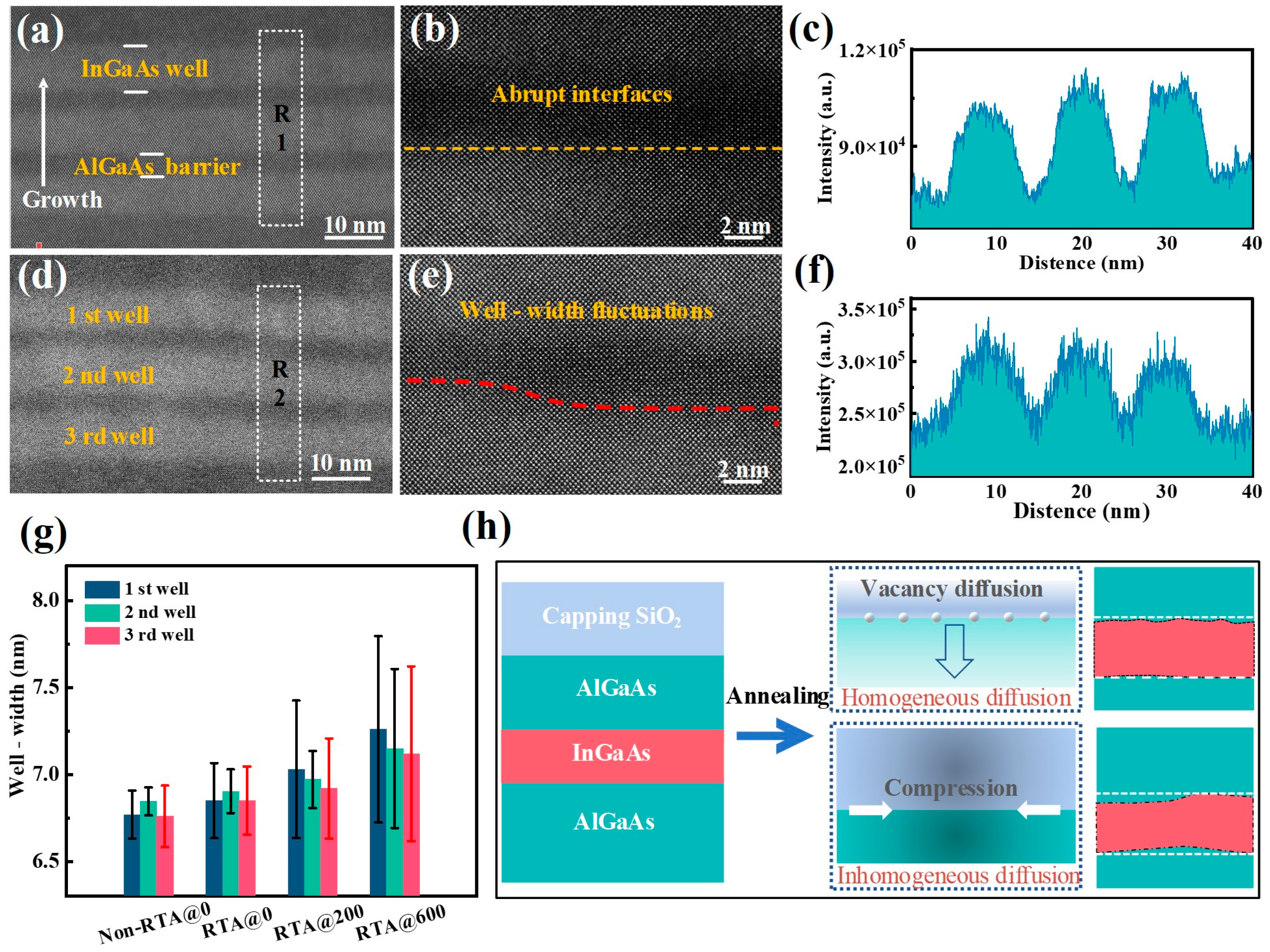
Disclaimer/Publisher’s Note: The statements, opinions and data contained in all publications are solely those of the individual author(s) and contributor(s) and not of MDPI and/or the editor(s). MDPI and/or the editor(s) disclaim responsibility for any injury to people or property resulting from any ideas, methods, instructions or products referred to in the content. |
© 2023 by the authors. Licensee MDPI, Basel, Switzerland. This article is an open access article distributed under the terms and conditions of the Creative Commons Attribution (CC BY) license (https://creativecommons.org/licenses/by/4.0/).
Share and Cite
Yang, Z.; Zhang, S.; Ma, S.; Shi, Y.; Liu, Q.; Hao, X.; Shang, L.; Han, B.; Qiu, B.; Xu, B. Effects of Thermal-Strain-Induced Atomic Intermixing on the Interfacial and Photoluminescence Properties of InGaAs/AlGaAs Multiple Quantum Wells. Materials 2023, 16, 6068. https://doi.org/10.3390/ma16176068
Yang Z, Zhang S, Ma S, Shi Y, Liu Q, Hao X, Shang L, Han B, Qiu B, Xu B. Effects of Thermal-Strain-Induced Atomic Intermixing on the Interfacial and Photoluminescence Properties of InGaAs/AlGaAs Multiple Quantum Wells. Materials. 2023; 16(17):6068. https://doi.org/10.3390/ma16176068
Chicago/Turabian StyleYang, Zhi, Shuai Zhang, Shufang Ma, Yu Shi, Qingming Liu, Xiaodong Hao, Lin Shang, Bin Han, Bocang Qiu, and Bingshe Xu. 2023. "Effects of Thermal-Strain-Induced Atomic Intermixing on the Interfacial and Photoluminescence Properties of InGaAs/AlGaAs Multiple Quantum Wells" Materials 16, no. 17: 6068. https://doi.org/10.3390/ma16176068
APA StyleYang, Z., Zhang, S., Ma, S., Shi, Y., Liu, Q., Hao, X., Shang, L., Han, B., Qiu, B., & Xu, B. (2023). Effects of Thermal-Strain-Induced Atomic Intermixing on the Interfacial and Photoluminescence Properties of InGaAs/AlGaAs Multiple Quantum Wells. Materials, 16(17), 6068. https://doi.org/10.3390/ma16176068





